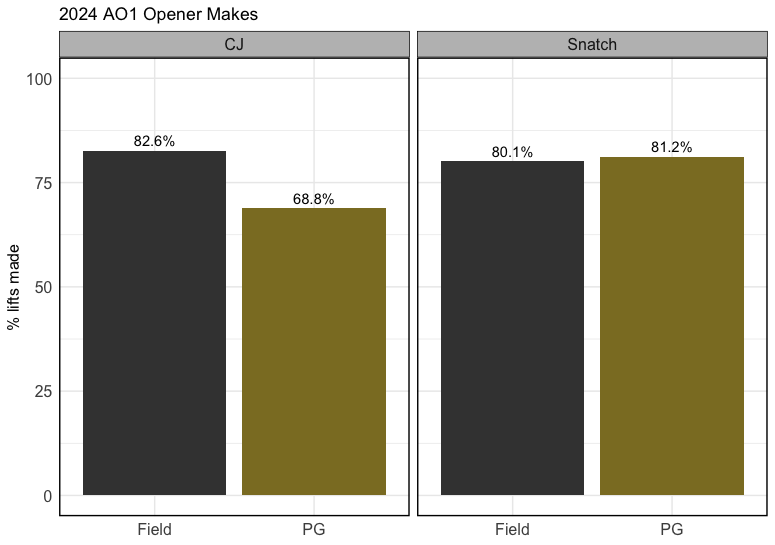Thus far, most of these blogs have been centered around using data to facilitate an athlete’s training, namely through monitoring fatigue and physical adaptations. However, there is another valuable way to get the most out of your weightlifters’ data that is accessible to every coach and is extremely easy to collect: competition results. Examining the athlete’s competition data (i.e., weight jumps, makes, misses, etc.) can provide valuable information that may aid in coaching tactics and strategy. Particularly, this may be useful to the coach to examine how their team performed compared to historical data, or it may be useful to see where the team is performing above or below the rest of the field. Subsequently, these insights could help guide how you, the coach, approach competitions and outline meet strategies. I will provide a brief example of how this could be addressed.
With the 2024 American Open Series 1 (AO1) now weeks behind us, we can look back at how Power and Grace performed relative to the rest of the field. Collecting this data is extremely simple. For your team, simply organize attempts and makes/misses throughout the competition weekend – now you have competition data on your team. Now, the seemingly challenging part is obtaining data from the other hundreds of lifters that competed. Fortunately, the crew at Milwaukee Barbell Club developed a website – Lift Oracle – specifically for being able to examine summary statistics from weightlifting meets, or even specific athletes. This takes a potentially massive obstacle that would likely require knowledge of data management and coding knowledge and makes it extremely user-friendly. Shoutout those guys. Next, I posed a few simple questions:
“How did Power and Grace perform across all attempts compared to the rest of the field?”
“How did Power and Grace perform in their opening attempts compared to the rest of the field?”
Our team had 17 athletes compete: 16 women and 1 man (accurate representation of our team demographics). Given this imbalanced dataset, and the gender-specific summary statistics provided by Lift Oracle, I only examined the field of women weightlifters within our team and the entire 2024 AO1 field.
Examining total attempts made during the 2024 AO1, Power and Grace made a greater proportion of lifts compared to the field at 67.7% versus 61.8% percent, respectively. However, given the sample size for both groups, we could not confidently say this difference was not due to random chance.
Examining the proportion of openers made, Power and Grace looks to have been on par with the rest of the field in the snatch: 80.1% made by the field, 81.2% made by Power and Grace. There is, however, an observable disparity in clean and jerk openers made, with the field and Power and Grace at 82.6% and 68.8% made attempt rates, respectively. Whilst this is a seemingly large disparity, the field consists of ~500 lifters whereas the Power and Grace sample consists of only 16 observations. Essentially, we need much more data from Power and Grace to determine whether this difference is from random change or if there is a true difference. Nonetheless, these descriptive statistics are still informative and can be used as the first step in competition performance self-evaluation.
Our case example outlines a very simple way to leverage available data in a way that benefits the coach’s athletes. Specifically, this data is useful for evaluating meet strategies. For instance, as a staff, we may discuss why the team performed below the rest of the field on clean and jerk openers. This may lead to the identification of a team-wide approach that could be determined as a contributing factor to this disparity, or it may warrant further historical analysis of how the team performed on clean and jerk openers in the past to decide whether the 2024 AO1 disparity may have been an outlier. Regardless, this is an excellent example of how a coaching staff can self-evaluate the competition approach and make an adjustment for the future, thereby better servicing the athlete and team.
Jake


